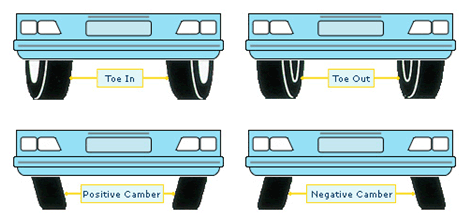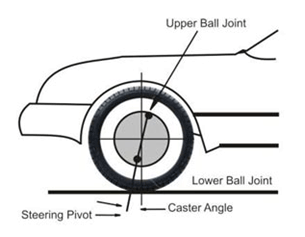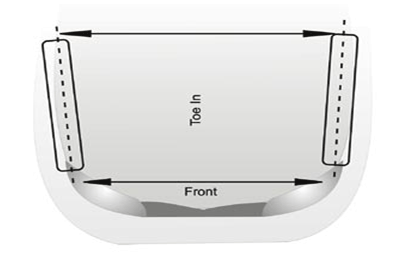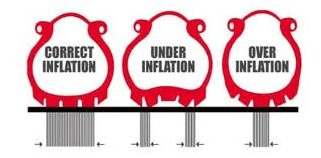Wheel Alignment
Wheel alignment sometimes referred to as tracking, is part of standard automobile maintenance that consists of adjusting the angles of the wheels so that they are set to the car maker's specification. The purpose of these adjustments is to reduce tyre wear, and to ensure that vehicle travel is straight and true (without "pulling" to one side).
Alignment is one of the key maintenance factors in getting the most wear and performance from your tyres. In addition, wheel alignment provides safe, predictable vehicle control as well as a smooth and comfortable ride, free of pulling or vibration, and improved gas mileage. Wheel alignment is done for proper return ability, less tyre wear, reduce load on suspension and better handling. Improper wheel alignment can effect driving performance of your vehicles as well as cost you money. It also improves your vehicle's gas mileage by decreasing your tyre's resistance and improves safety by avoiding steering accidents.
There are three main parameters of Alignment, Camber, Caster and Toe. Return ability is the ability of the steering to get into position while the wheel moves.
Camber is the inclination of the tyres when viewed from front. The camber is negative if the top of the wheel leans inwards and if it is leaning outwards then the camber is positive. Positively cambered tyres are beneficial during rains to drain the water. To stay in a straight line positive camber is set on the front tyres. Rear tyres have zero camber.

Caster
The inclination of the steering pivot to the front or backward direction, to adjust the steering is Caster. The front angle indicates positive caster while the backwards indicate negative caster.
Rear wheel drive cars have positive caster and front wheel drive cars have negative caster. Caster is only made present in front wheels because of their ability to steer.

Toe-in, Toe-out :
The difference of the lateral distance between the front end of the front tyres and the rear end of the front tyres is toe measurement. Toe-in suggests front end of the tyre is closer and in toe-out means it's away.

Tyre Rotation :
Tyre Rotation is an essential for longer tyre life and even its wear. With the front tyres having positive camber angle, the inside edge of the tyre wears faster, hence changing a front tyre with the diagonally opposite rear tyre will increase the life of a tyre, the tyre which is now at the rear end will wear from the centre as the rear end has no camber. The tyres should be rotated every 5,000 km even if there is no mention of the same in the manual.
Proper Inflation :
Tyre pressure is a very important aspect in the wear of a tyre. The tyre pressure less than the recommended results in the wastage of energy. Also, if the centre of the contact patch doesn't touch the ground reducing the contact patch and tyre wear increases. When the tyre is overinflated, the contact patch is less, the efficiency increases a bit but the handling wears.

Wheel Balancing
For the tyres to rotate smoothly and to prevent vibrations, the entire assembly of tyres has to be well balanced. If a wheel is not balanced, then one segment of the tyre will become lighter and the opposite end will become heavier causing the vibrations.
Static Balancing
In static balancing, the wheel and tyre assembly is mounted on a hub and is rotated by hand. The tyre rotates and eventually slows down. While slowing down, the tyre begins to oscillate with reducing amplitude. Once the tyre comes to a halt, the lowest point is marked with a chalk and then again rotated after moving the mark end to 90 degrees from the lowest point. If the marked point again comes to a halt at the lowest point then this indicates that it's the heaviest point on the assembly and weight is added to the opposite side. This is continued till the wheel is balanced.
Dynamic Balancing
In this form of balancing, the wheel assembly is attached to the machine, which spins the whole assembly and calculates the amount of weight required at different locations to balance the wheel and tyre.
Tyre Change
The tyre presently in use should be replaced with a new tyre when the tread wear indicator is exposed. The tyre wear indicator normally is present at a height of 1.6 mm.
Maintenance of Inflation Pressure
The inflation pressure recommended by the vehicle manufacturer should always be maintained. Inflation pressure of a cold tyre should always be maintained. Inflation pressure should be checked every week and before long drives. Air leakage should be checked for. The valve core should be renewed timely and lost valve cap should be replaced. New tyres tend to expand during a certain initial period and increase its volume. This decreases the inner pressure, so frequent checking of pressure is recommended up to 3000 kms. The inflation pressure of the spare tyre 5 psi (3.0 kgf/cm2) should be maintained, higher than the recommended pressure and before using, bring inflation pressure to the recommended pressure.


